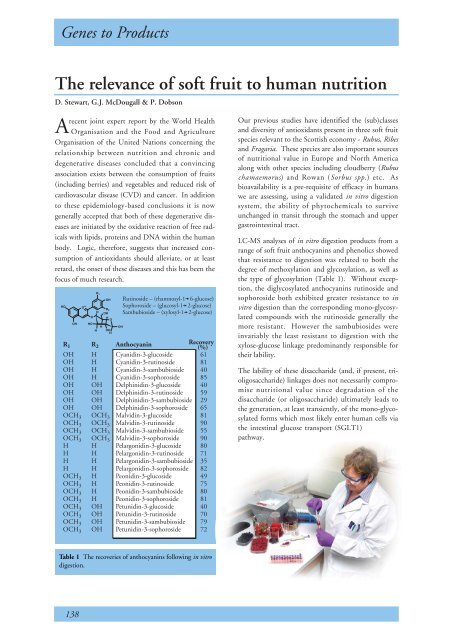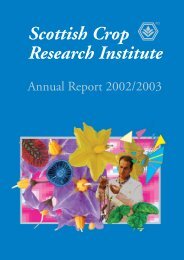SCRI Annual Report 2003/2004 - Scottish Crop Research Institute
SCRI Annual Report 2003/2004 - Scottish Crop Research Institute
SCRI Annual Report 2003/2004 - Scottish Crop Research Institute
Create successful ePaper yourself
Turn your PDF publications into a flip-book with our unique Google optimized e-Paper software.
Genes to Products<br />
The relevance of soft fruit to human nutrition<br />
D. Stewart, G.J. McDougall & P. Dobson<br />
Arecent joint expert report by the World Health<br />
.Organisation and the Food and Agriculture<br />
Organisation of the United Nations concerning the<br />
relationship between nutrition and chronic and<br />
degenerative diseases concluded that a convincing<br />
association exists between the consumption of fruits<br />
(including berries) and vegetables and reduced risk of<br />
cardiovascular disease (CVD) and cancer. In addition<br />
to these epidemiology-based conclusions it is now<br />
generally accepted that both of these degenerative diseases<br />
are initiated by the oxidative reaction of free radicals<br />
with lipids, proteins and DNA within the human<br />
body. Logic, therefore, suggests that increased consumption<br />
of antioxidants should alleviate, or at least<br />
retard, the onset of these diseases and this has been the<br />
focus of much research.<br />
HO<br />
OH<br />
R 1<br />
OH<br />
OH<br />
OH<br />
OH<br />
OH<br />
OH<br />
OH<br />
OH<br />
OCH 3<br />
OCH 3<br />
OCH 3<br />
OCH 3<br />
H<br />
H<br />
H<br />
H<br />
OCH 3<br />
OCH 3<br />
OCH 3<br />
OCH 3<br />
OCH 3<br />
OCH 3<br />
OCH 3<br />
OCH 3<br />
R 1<br />
OH<br />
O +<br />
R 2<br />
H OH<br />
O H<br />
O<br />
HO<br />
H<br />
H OH<br />
H<br />
R 2<br />
H<br />
H<br />
H<br />
H<br />
OH<br />
OH<br />
OH<br />
OH<br />
OCH 3<br />
OCH 3<br />
OCH 3<br />
OCH 3<br />
H<br />
H<br />
H<br />
H<br />
H<br />
H<br />
H<br />
H<br />
OH<br />
OH<br />
OH<br />
OH<br />
OH<br />
Rutinoside – (rhamnosyl-1 6-glucose)<br />
Sophoroside – (glucosyl-1 2-glucose)<br />
Sambubioside – (xylosyl-1 2-glucose)<br />
Anthocyanin<br />
Cyanidin-3-glucoside<br />
Cyanidin-3-rutinoside<br />
Cyanidin-3-sambubioside<br />
Cyanidin-3-sophoroside<br />
Delphinidin-3-glucoside<br />
Delphinidin-3-rutinoside<br />
Delphinidin-3-sambubioside<br />
Delphinidin-3-sophoroside<br />
Malvidin-3-glucoside<br />
Malvidin-3-rutinoside<br />
Malvidin-3-sambubioside<br />
Malvidin-3-sophoroside<br />
Pelargonidin-3-glucoside<br />
Pelargonidin-3-rutinoside<br />
Pelargonidin-3-sambubioside<br />
Pelargonidin-3-sophoroside<br />
Peonidin-3-glucoside<br />
Peonidin-3-rutinoside<br />
Peonidin-3-sambubioside<br />
Peonidin-3-sophoroside<br />
Petunidin-3-glucoside<br />
Petunidin-3-rutinoside<br />
Petunidin-3-sambubioside<br />
Petunidin-3-sophoroside<br />
Recovery<br />
(%)<br />
61<br />
81<br />
40<br />
85<br />
40<br />
59<br />
29<br />
65<br />
81<br />
90<br />
55<br />
90<br />
80<br />
71<br />
35<br />
82<br />
49<br />
75<br />
80<br />
81<br />
40<br />
70<br />
79<br />
72<br />
Our previous studies have identified the (sub)classes<br />
and diversity of antioxidants present in three soft fruit<br />
species relevant to the <strong>Scottish</strong> economy - Rubus, Ribes<br />
and Fragaria. These species are also important sources<br />
of nutritional value in Europe and North America<br />
along with other species including cloudberry (Rubus<br />
chamaemorus) and Rowan (Sorbus spp.) etc. As<br />
bioavailability is a pre-requisite of efficacy in humans<br />
we are assessing, using a validated in vitro digestion<br />
system, the ability of phytochemicals to survive<br />
unchanged in transit through the stomach and upper<br />
gastrointestinal tract.<br />
LC-MS analyses of in vitro digestion products from a<br />
range of soft fruit anthocyanins and phenolics showed<br />
that resistance to digestion was related to both the<br />
degree of methoxylation and glycosylation, as well as<br />
the type of glycosylation (Table 1). Without exception,<br />
the diglycosylated anthocyanins rutinoside and<br />
sophoroside both exhibited greater resistance to in<br />
vitro digestion than the corresponding mono-glycosylated<br />
compounds with the rutinoside generally the<br />
more resistant. However the sambubiosides were<br />
invariably the least resistant to digestion with the<br />
xylose-glucose linkage predominantly responsible for<br />
their lability.<br />
The lability of these disaccharide (and, if present, trioligosaccharide)<br />
linkages does not necessarily compromise<br />
nutritional value since degradation of the<br />
disaccharide (or oligosaccharide) ultimately leads to<br />
the generation, at least transiently, of the mono-glycosylated<br />
forms which most likely enter human cells via<br />
the intestinal glucose transport (SGLT1)<br />
pathway.<br />
Table 1 The recoveries of anthocyanins following in vitro<br />
digestion.<br />
138
















